This paper was presented at the Tenth International Symposium on Skiing Trauma & Safety held at Zell am See, Austria, May 17-21, 1993.
A REVIEW OF WATER-SKIING SAFETY IN THE USA
by
Roberts, Charles C., Jr., Ph.D.
C. Roberts Consulting Engineers, Inc.
46W192 Granart Rd., Big Rock, IL 60511, USA
ABSTRACT
Water-skiing safety in the United States of America is primarily governed by the American Water Ski Association (AWSA). Safety information, equipment standards, and competition safety procedures are among many of the documents promulgated by the association. Water-skiing equipment related standards and procedures are reviewed. A U.S. Consumer Product Safety Commission, Nation Electronic Injury Surveillance System (NEISS) survey of water-skiing injuries was performed over a period from 1980-1991 showing injury trends over that period. Data on injury modes is presented. Typical water-skiing safety equipment is presented along with equipment characteristics. Future safety related developments are discussed.
INTRODUCTION
The first person to water-ski did so in 1922 in the state of Minnesota, USA. He used two large skis and was towed by an airplane equipped with floats. Water-skiing evolved to its present form with nearly 17 million Americans water-skiing (1).
Water-skiing takes the form of slalom skiing, trick skiing, jumping, knee boarding, ski-boarding, speed skiing, kite flying, show skiing, and barefoot water-skiing.
Figure 1 is a view of a typical slalom water-skier. The single slalom ski allows the skier to attain a high degree of inclination with respect to the water allowing quick turns for negotiating a standard slalom course. Figure 2 is a view of a trick skier performing a toe/back with a foot in the tow rope. The skier scores points by performing as many different prescribed tricks as possible in two 20 second runs. Figure 3 is a view of a knee boarder riding a kneeboard, a small surfboard like ski that has become popular in recent years. Many recreational water-skiers use combination sets of skis, i.e. two slalom-like skis for beginners and intermediates and the single ski for the advanced skiers. Figure 3.1 is a view of a jumper performing over a standard jump with specially designed jump skis and helmet.


The common aspect of these water sports is the towing of the participant on some apparatus or body part that provides hydrodynamic lift. The participant is usually free to maneuver laterally in and out of the tow boat wake. Skier speeds in excess of 80 KPH are attained in slalom courses with towrope loading in excess of 2000 N.
The American Water Ski Association (AWSA) is the primary governing body for water-skiing in the USA. AWSA promulgates safety, instructional and administrative information regarding water-skiing. AWSA develops standards for equipment and competition procedures. AWSA also tests and approves water-skiing equipment. The KneeBoard Association and Barefoot Club are affiliated with the AWSA.
INJURY STATISTICS
A U.S. Consumer Product Safety Commission, National Electronic Injury Surveillance System (NEISS) query was performed on water-skiing accidents from 1980 through 1991. Figure 4 shows total reported injuries versus 1000 water-skiing days. The injury rate varied from .18 to .32 reported injuries/1000 water-skiing days. The
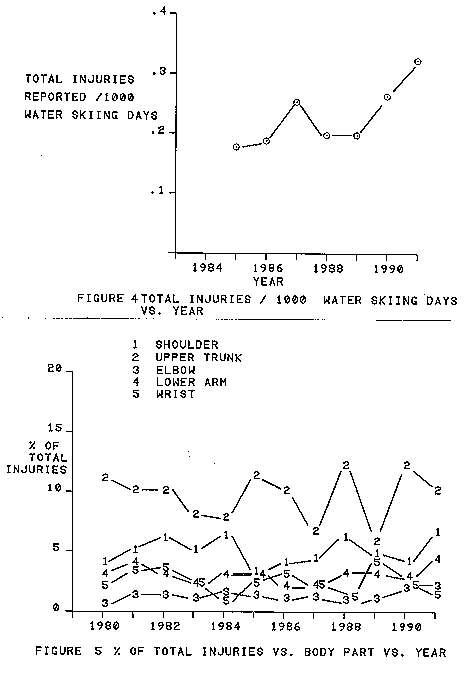
injury rate appears to be increasing slightly over the period of 1985 to 1991. The estimate of total participants in the sport was taken from the National Sporting Goods Association (NSGA) (Ref. 2). Table 4 shows the total

reported injuries from 1980 to 1991 averaging approximately 23,400 injuries per year with approximately 76% of the injuries sustained by male participants. Approximately 61% of the participants are males. Figures 5 through 8 show graphs of injury related trends according to body part. Knee and facial injuries account for the highest percentage but do not dominate the total mix of injuries. Upper body parts tend to account for many of the injuries. The data appears to indicate no particular trend in body parts being injured over the period of analysis.
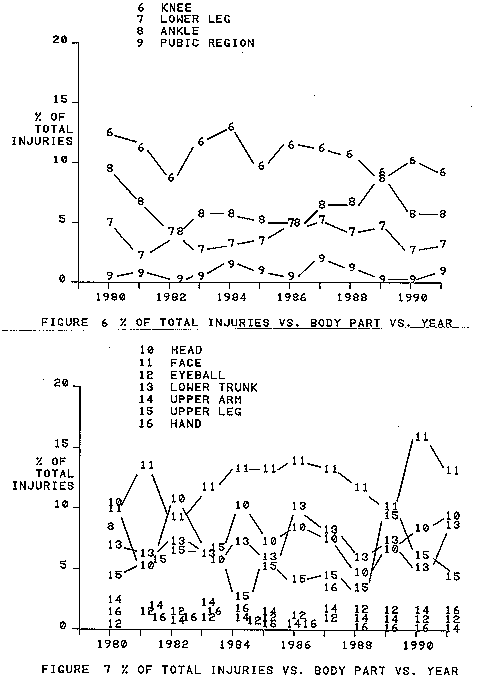
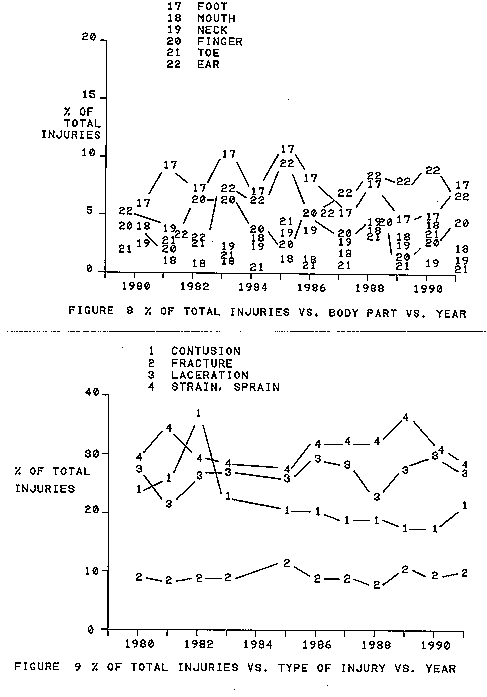
Figure 9 shows the types of injuries that are occurring per year. Contusions, lacerations and strain/sprains tend to dominate the data. Fractures are the 4th most common injury with approximately 10% of the total mix. Concussions, dislocations, internal injury, hematoma, puncture, avulsion and other injuries account for less than 15% of the total injury types. Injury type trends appear to be stable over the study period. The injury rate is low when compared to other sports such as snow skiing which is usually characterized by 10 times the injury rate. There does not appear to be a trend in the body part injured nor the type of injury sustained over the study period. There appears to be a slight increase in injury rate from approximately 0.18 to 0.32 injuries per 1000 skiing days.
MODES OF INJURY
There is little comprehensive data regarding water-skiing injury modes. The following is a review of major injury modes observed over several years.
Skier interaction with the water-ski accounts for facial injuries and lacerations. If a slalom skier leans too far forward, he can be pulled over the ski, falling forward and striking the ski, often with the face. Lacerations from the water-ski are also a common result of a fall. Rear foot release from a slalom ski allows opportunity for the front leg to twist which can result in a leg injury during a fall.
Interaction with water during a fall is a common cause of injuries. In some instances, slalom skiers falling with a hyper-flexed leading leg may sustain a torsional femur fracture. This is a result of the torque generated around the femur as a result of the tibia moment arm and lateral forces from the water-ski.
Interaction with the towrope is a common cause of water-skiing injuries. If a skier engages a limb in the towrope during a fall, severe injury can occur while being dragged through the water at high speed. In instances where a skier is late in releasing the rope during a fall, the rope and handle can be drawn across the body resulting in rope abrasion and laceration.
Interaction with the shore and other obstructions is a common cause of injury. Collisions with docks, pilings, moored boats, and floating debris account for many injuries.
Interaction with the towboat can result in severe injury to the skier, especially those injuries associated with the boat propeller.
When falls occur at high speeds such as in barefoot skiing or speed skiing, the body tends to plane hydrodynamically on the water. As the body slows, limbs can engage in the water resulting in serious injuries. Severe neck injuries have been sustained by barefoot skiers during falls.
WATER SKIING SAFETY EQUIPMENT
Figure 10 is a view of special glasses and a leg spray protector often used by slalom skiers. For those water-skiers requiring corrective lenses, special glasses are available to conform to the bridge area around the nose without sharp edges. This tends to reduce facial injuries that can occur with standard glasses when the skier falls face first. The spray protector eliminates the hydrodynamic abrasion that occurs during slalom skiing in a course at high speeds and increased inclination of the skier.
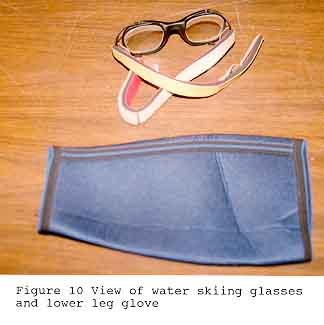
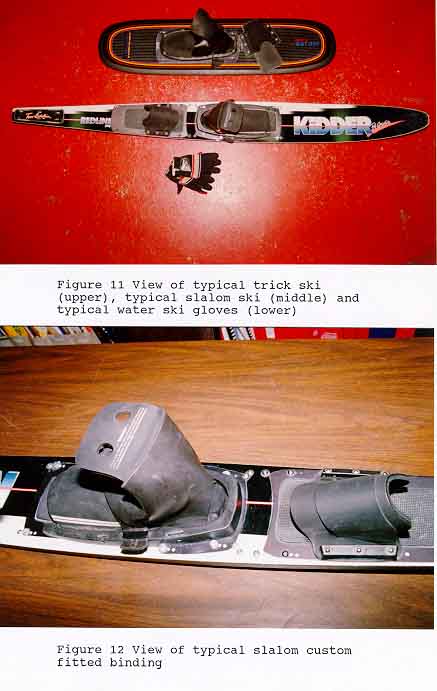
Figure 11 is a view of a trick ski (top), a slalom ski (middle) and a pair of gloves (bottom). The gloves help prevent blistering of the hands from the ski handle which may sustain loads in excess of 2000 N during a slalom run. The slalom ski is equipped with a trailing fin to aid stability. The trick ski has no trailing fin since surface rotation and backward skiing are integral parts of trick skiing.
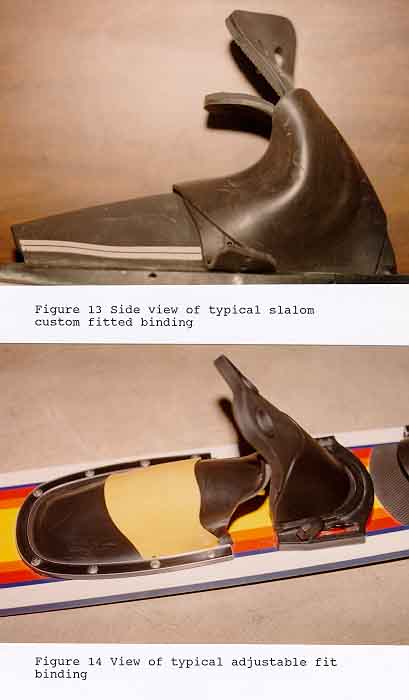
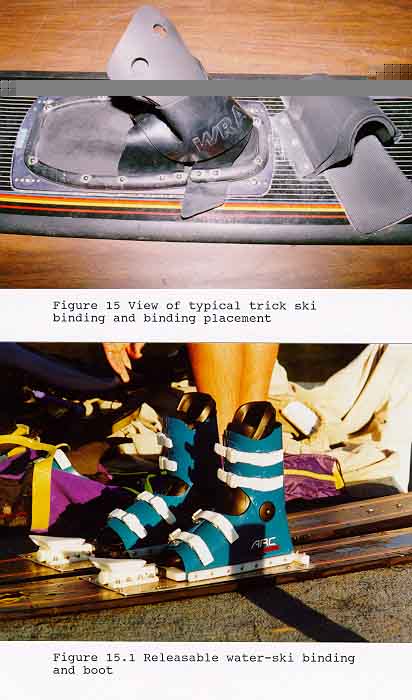
Figures 12 and 13 are views of a standard custom fitted water-ski binding. Figure 14 shows an adjustable water-ski binding. Figure 15 is a view of a typical trick ski binding installation with the rear foot cuff placed close to the leading leg for ease in rotary movements. Water-ski bindings are usually constructed from a flexible polymer and are designed to secure the foot to the ski and release under certain conditions. During a fall, water-skis may release depending on the dynamics of the fall. However, there are no standards or means for setting a particular release function on the bindings shown in Figures 12-15. Various degrees of forward lean release, twist release and the combination of the two releases do occur in water-skiing. This tends to be a function of the tightness of the binding and the friction between the foot and the binding. Generally, the standard bindings release in forward lean (M3, Ref. 5) quite readily. The twist release (M1) is limited on most standard water-ski bindings. For twist release, the heel must rise, thereby giving clearance for the heel to move laterally, resulting in a twist release (M1). For the combined loading condition of forward lean and twist (M3,M1) most bindings release readily.
Releasable water-ski bindings have been tested and used on a limited basis for several years. Figure 15.1 is a view of a releasable water-ski boot/binding system. A water-ski boot is secured to a plate that is attached to the ski. Release capability is multi-modal with forward, twist and rearward release. The binding setting is selected by the skier according to a chart derived from snow skiing research. The user selects weight, height, and ability on a chart, which yields the recommended binding release setting. Releasable water-ski bindings appear to be useful in jumping and trick skiing. In jumping, two skis are used, which allows for injury producing torque to be transmitted to the legs. Likewise, in trick skiing as shown in Figure 2, injury producing torque can be transmitted to the supporting leg when falling in the toe trick mode. For the slalom skier, both feet are secured to the ski, which tends to limit independent rotation of the ski about one leg. In this case, a releasable binding may be less useful because of the inherent protection of such a body position. In snowboarding, similar reasoning has led that industry not to actively pursue release capability of snowboard bindings.
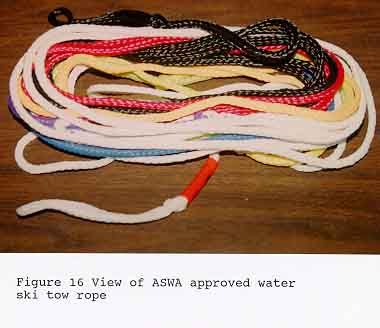
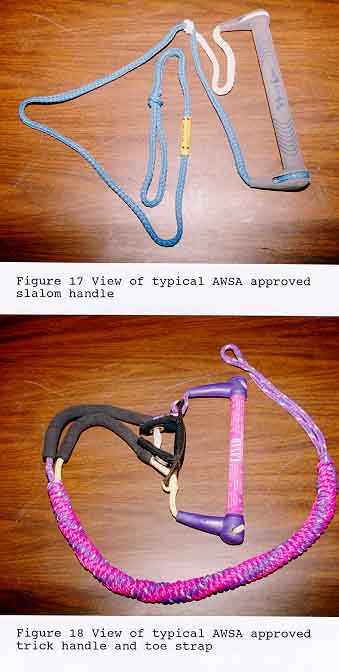
Figure 16 is a view of an AWSA approved water-ski rope. Figure 17 is a view of a standard AWSA approved slalom ski handle. The handle should have no pinch points that could engage a skier's finger during a fall. Figure 18 is a view of a typical trick ski handle with the foot stirrup for toe tricks.
Figure 19 is a view of a standard AWSA towboat. The boat must meet certain dimensions, horsepower, wake and water-ski equipment requirements. Figure 20 is a view of an AWSA approved towing lug or pylon. The slalom rope is attached to the upper eye in the pylon. Figure 20 shows a trick ski rope release mechanism, which is often used when toe tricks are being performed. Certain ski tricks require the skier to be towed by the foot as shown in Figure 2. If the skier falls and the towrope does not disengage from the skier, a serious injury could occur. Consequently, several trick release designs have evolved; one of which is shown in the example of Figure 20. The observer pulls the tow rope release when a fall is imminent, thereby severing connection to the tow boat and possibly eliminating a severe injury.
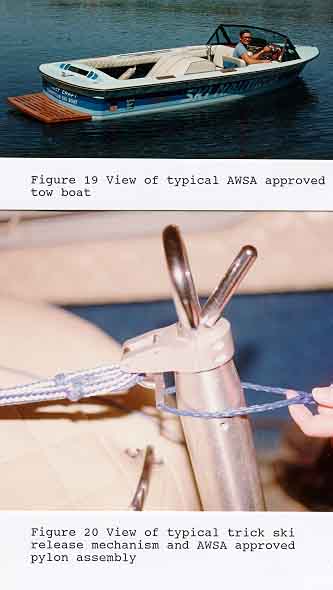
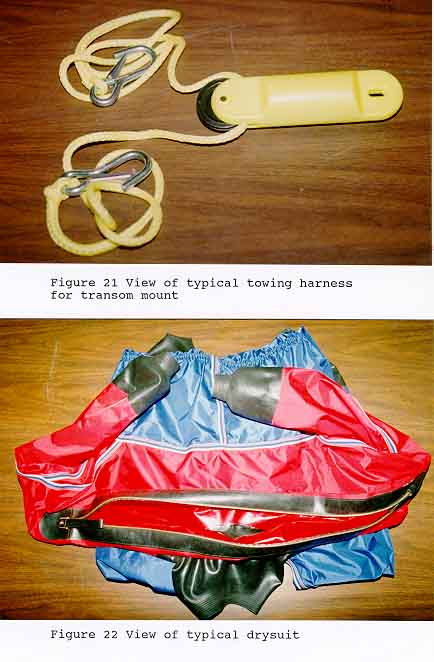
Figure 21 shows another popular way to secure the rope to the boat by using a bridle attachment system. The bridle rope or cable is attached to the transom of the towboat and the rope attached to the float/pulley. This allows water-skiing capability for a boat not equipped with a pylon.
Figure 22 is a view of a drysuit used for skiing in cold water and during cold weather early and late in the water-skiing season.
COMPETITION WATER SKIING STANDARDS
As the primary governing body for water skiing in the USA, the American Water Skiing Association (AWSA) oversees safety at AWSA sanctioned tournaments and represents the interest of recreational skiers as well. At the AWSA sanctioned tournaments, safety check out of equipment is performed by AWSA officials. This is typically a visual inspection looking for loose screws and worn out or damaged bindings. Personal flotation devices and helmets for ski jumping are required at the tournaments. A tow rope shock tube, used to reduce recoil of the rope in case of a skier fall, is also required. The three major tournament categories are slalom, trick skiing and jumping.
The slalom skier is pulled by a motor boat approved by the AWSA. The slalom course is a recognized standard throughout the world. During the slalom run, a safety boat stands by in case of an in the water emergency, ready to aid a skier. The towboat is required to have a safety observer to alert the boat driver as to the status of the skier, i.e. skiing or fallen down. An AWSA approved towrope is required along with a personal flotation device. In some instances a slalom skier wears a spray protector on the trailing lower leg to prevent a burn from the water spray.
Trick skiing entails performing as many different tricks on a finless ski for two 20 second time periods. The towboat must have a safety observer and a person who controls the tow rope release when toe tricks are being performed. The skier must have an AWSA approved tow rope. A toe release is recommended if the skier is performing toe tricks.
In ski jumping, a helmet and personal flotation device is required. A safety boat is also on duty to render assistance to the water-skier.
The AWSA has developed several test methods and requirements for water-skiing equipment. There is a standard slalom ski course and trick ski course. Towboats should be approximately 6m long and no wider than 2.5m. A towing pylon is required in the boat, which must sustain a minimum loading of 600 kg. The water-ski width must not exceed 30% of its length. The towlines must have a breaking strength of 5800 N as well as meeting other dimensional standards. The tow handle must sustain a load of 4000 N. AWSA has developed a set of hand signals used to communicate between the boat observer and skier.
These are typical examples of AWSA competition requirements. They are widely used by the recreational water-ski industry, as well. More detail is available in references (1) and (3).
CLOSING
Water-skiing injury rates range from 0.2 to 0.3 injuries per 1000 skier days. This rate is quite low when compared to other sports such as snow skiing which has injury rates 10 times higher. Lower leg and head injuries tend to be the higher percentage of injuries but do not dominate the injury mix. No single body part injury exceeds 15% of the total injury mix. Approximately 76% of all injured water-skiers are male. Contusions, lacerations and strain/sprains lead the mix of injury types. The American Water Ski Association promulgates safety standards on water-skiing equipment and practices and is considered the governing body for water-skiing in the USA. Standards for tow ropes, handles, towboats, competition courses and safety practices have been developed. Future developments are in the areas of helmet design and releasable water-ski bindings.
REFERENCES
1. Safe Water Skiing, The American Water Ski Association, Winter Haven, Florida.
2. National Sporting Goods Association Research, Mt. Prospect, Illinois.
3. Official Tournament Rules, The American Water Ski Association, Winter Haven, Florida.
4. U.S. Consumer Product Safety Commission, Nation Electronic Injury Surveillance System (NEISS) survey of water-skiing, 1972-1991.
5. "Standard Method for Measuring the Release Moments of Adult Alpine Ski Bindings", ASTM F504.















